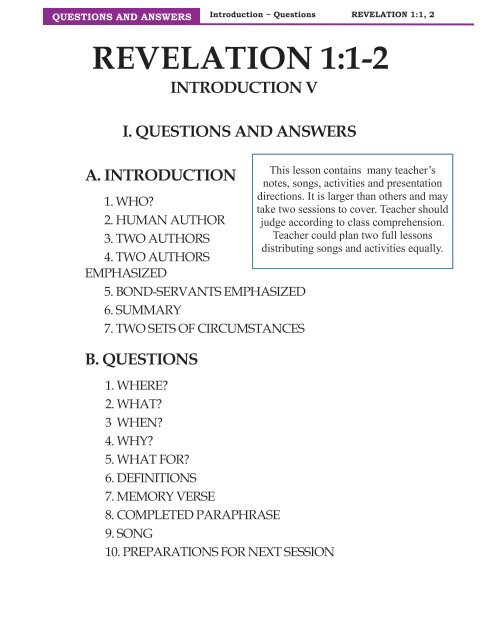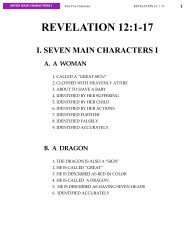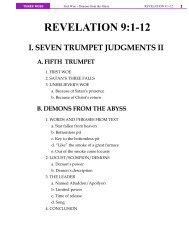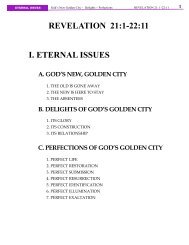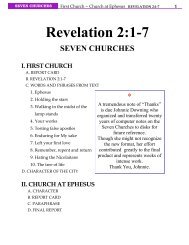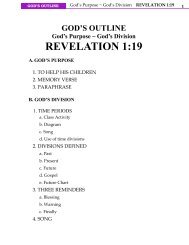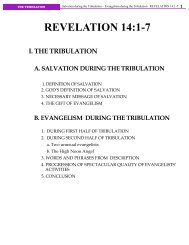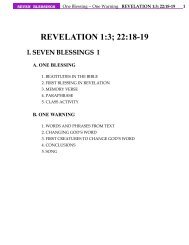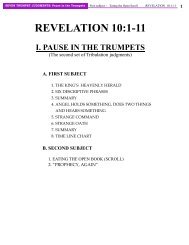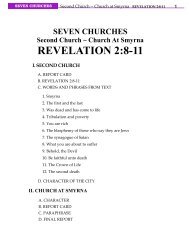5. Intro 5 - Questions & Answers - Technology Ministries
5. Intro 5 - Questions & Answers - Technology Ministries
5. Intro 5 - Questions & Answers - Technology Ministries
You also want an ePaper? Increase the reach of your titles
YUMPU automatically turns print PDFs into web optimized ePapers that Google loves.
QUESTIONS AND ANSWERS <strong>Intro</strong>duction ~ <strong>Questions</strong> REVELATION 1:1, 2<br />
REVELATION 1:1-2<br />
INTRODUCTION V<br />
I. QUESTIONS AND ANSWERS<br />
A. INTRODUCTION<br />
1. WHO?<br />
2. HUMAN AUTHOR<br />
3. TWO AUTHORS<br />
4. TWO AUTHORS<br />
EMPHASIZED<br />
<strong>5.</strong> BOND-SERVANTS EMPHASIZED<br />
6. SUMMARY<br />
7. TWO SETS OF CIRCUMSTANCES<br />
B. QUESTIONS<br />
1. WHERE?<br />
2. WHAT?<br />
3 WHEN?<br />
4. WHY?<br />
<strong>5.</strong> WHAT FOR?<br />
6. DEFINITIONS<br />
7. MEMORY VERSE<br />
8. COMPLETED PARAPHRASE<br />
9. SONG<br />
10. PREPARATIONS FOR NEXT SESSION<br />
This lesson contains many teacher’s<br />
notes, songs, activities and presentation<br />
directions. It is larger than others and may<br />
take two sessions to cover. Teacher should<br />
judge according to class comprehension.<br />
Teacher could plan two full lessons<br />
distributing songs and activities equally.
2 REVELATION is NOT a Mystery—TEACHER’S GUIDE<br />
INTRODUCTION V<br />
REVELATION CHAPTER 1<br />
INTRODUCTION V<br />
**PREPARATIONS FOR DEMONSTRATING THE MEANING OF<br />
“REVELATION”.<br />
A large picture of Jesus Christ covered with a thick drape should be on an easel in an<br />
inconspicuous spot before students arrive. Be careful! Do not allow anyone to get too close to<br />
the exhibit. If anyone peeps under the cover before the correct time, the impact of the<br />
demonstration is lost. If students inquire, tell them the easel will be explained later. A double<br />
asterisk ** in Teacher‟s Guide identifies where to present the demonstration.<br />
OPENING PRAYER<br />
Take a few moments to prepare your souls for the intake of God‟s Word. Admit any known<br />
sins to God the Father, and consciously switch your attention away from the things of the<br />
world toward the things of God.<br />
Dear Heavenly Father, We call on Your Spirit to guide us into all truth as we study Your<br />
Word together. Thank You, Father, for young people who love Your Word. In Jesus‟ name,<br />
we pray. Amen.<br />
REVIEW<br />
Vocabulary List<br />
Prophecy: a pre-written record of future events.<br />
History: a record of the statements, characters and flow of past events.<br />
Poetry: beautifully flowing text with lovely descriptions and vivid word pictures.<br />
Letters: written messages sent to a definite person or group of people.<br />
God‘s Library: the 66 books in the Bible inspired by God. Scripture; God‟s Word.<br />
Seven Churches: the seven churches in Asia written to in 96 A.D. by John: a term<br />
signifying all believers from the Day of Pentecost until the Rapture.<br />
Summary:<br />
As the last book in the Bible, the prophecy of REVELATION, must be studied for a well<br />
rounded knowledge of God‟s Word. God has placed many study aids within its pages to<br />
demonstrate REVELATION is not a mystery, but a slowly unfolding message sent<br />
specifically to believers of the Church Age.<br />
CLASS ACTIVITY POSSIBILITIES<br />
1. Song: “John the Apostle on the Isle of Patmos” is classified as an activity. Materials and<br />
directions are in Teacher‟s Appendix and Student Songbook, p.147, Directions are on<br />
following page in Songbook.
QUESTIONS AND ANSWERS <strong>Intro</strong>duction ~ <strong>Questions</strong> Revelation 1:1-2<br />
3<br />
2. Students may write answers to questions “Who, Where, What, When and<br />
Why?” in Student Workbook or on special outlines.<br />
3. Symbols for the chain of communication (in Student Workbook and<br />
Teacher‟s Appendix) may be cut out and pasted together in the correct order.<br />
I. QUESTIONS AND ANSWERS<br />
A. INTRODUCTION<br />
College Journalism professors suggest pausing regularly to ask<br />
five simple questions when studying any subject: ―Who?,<br />
Where?, What?, When?, and Why?‖ We begin by asking the<br />
question, ―Who?‖<br />
1. WHO? Who wrote the book of Revelation?<br />
a. The Holy Spirit superintended.<br />
GOD THE FATHER AND GOD THE HOLY SPIRIT WATCHED<br />
OVER THE WRITING OF ALL SCRIPTURE.<br />
II PETER 1:20, 21 But know this first of all, that no<br />
prophecy of Scripture is a matter of one‟s own<br />
interpretation, for no prophecy was ever made by<br />
an act of human will, but men moved by the Holy<br />
Spirit spoke from God.<br />
REVELATION 1:1 makes clear that Jesus Christ is involved in the<br />
writing of this book. All three members of the Tri-Unity are involved in<br />
the recording of “THE REVELATION OF JESUS CHRIST”, but God<br />
the Son is the member of the Trinity most personally involved.<br />
Because it is His revelation.<br />
b. A human penman recorded the words.<br />
Look at REVELATION 1:1. See if students can identify the human author.<br />
REVELATION 1:1 The Revelation of Jesus Christ,<br />
which God gave Him to show to His bondservants,<br />
the things which must shortly take place;<br />
and He sent and communicated it by His angel to<br />
His bond-servant John.
4 REVELATION is NOT a Mystery—TEACHER’S GUIDE<br />
INTRODUCTION V<br />
Direct attention to verse four, then, look at verses eleven and nineteen.<br />
REVELATION 1:4 John to the seven churches that<br />
are in Asia: Grace to you and peace from Him who<br />
is and who was and who is to come; and from the<br />
seven Spirits who are before His throne.<br />
REVELATION 1:11 ...SAYING, “Write in a book<br />
what you see, and send it to the seven churches: to<br />
Ephesus, Smyrna, Pergamum, and to Thyatira and<br />
to Sardis and to Philadelphia and to Laodicea.”<br />
REVELATION 1:19 Write therefore (the heavenly<br />
director, speaking to John) the things which you have<br />
seen, and the things which are, and the things<br />
which shall take place after these things.<br />
c. Heaven is directing.<br />
Do you get the idea that someone in heaven is directing someone on<br />
earth? There is only one human called by name in REVELATION 1:1.<br />
All others are heavenly beings. A man was commissioned to record<br />
this book for all members of the True Church on earth and his name is<br />
John.<br />
2. HUMAN AUTHOR<br />
A. We see from REVELATION 1:1 the human author‟s name is John.<br />
John an apostle of Jesus Christ is accepted by Theologians as the human<br />
penman of the book of REVELATION.<br />
“The Hebrew idioms in the book, the authority of the author in relation to the<br />
churches, the use of distinctively Johannine terms such as logos and “Lamb of<br />
God,” and the corroboration of Irenaeus, Origen, Tertullian, and Clement all<br />
affirm that the apostle John was the author of this book.” Revelation, Ryrie,<br />
Charles C. The Lochman Foundation, La Habra, California. 1996, P. 14<br />
Direct students to write, “The apostle, John” under “Who wrote the book of<br />
REVELATION?”<br />
3. TWO AUTHORS<br />
Both authors of THE REVELATION OF JESUS CHRIST are named<br />
and both authors are emphasized in The Chain of Communication.<br />
REVELATION 1:1; 4, 5 and 11 make it clear that Jesus Christ is the<br />
heavenly Author directing John, the earthly author.<br />
THE HEAVENLY AUTHOR, JESUS CHRIST, DIRECTS THE
QUESTIONS AND ANSWERS <strong>Intro</strong>duction ~ <strong>Questions</strong> Revelation 1:1-2<br />
5<br />
HUMAN WRITER, JOHN, TO RECORD THE MESSAGE GOD<br />
WANTS TO SEND.<br />
a. Heavenly author.<br />
1) The entire Bible in its original languages came from God through<br />
human writers directed by the Holy Spirit and protected from<br />
recording errors. God the Holy Spirit moved on the minds of certain<br />
chosen men so that what they wrote was...the Word of God.<br />
The moving of the Holy Spirit over those recording Scripture is the doctrine<br />
of Inspiration, one of the basic components of Bibliology. Information for<br />
further study of Bibliology is in Teacher‟s Appendix.<br />
TIMOTHY 3:16 All scripture is given by<br />
inspiration of God (is “God-breathed”) and is<br />
profitable for doctrine, for reproof, for correction,<br />
for instruction in righteousness.<br />
II PETER 1: 21 For no prophecy was ever made by<br />
an act of human will, but men moved by the Holy<br />
Spirit spoke from God.<br />
2) Resounding evidence points to the apostle John as the human<br />
writer. John, a beloved disciple of Jesus Christ, declares himself to be<br />
the human author four times in the book of REVELATION. His<br />
reminders are spaced throughout the book so the student will not<br />
forget.<br />
REVELATION 1:1 The Revelation of Jesus Christ,<br />
which God gave Him to show to His bondservants,<br />
the things which must shortly take place;<br />
and He sent and communicated it by His angel to<br />
His bond-servant John.<br />
REVELATION 1:4 John to the seven churches that<br />
are in Asia: Grace to you and peace, from Him<br />
who is and who was and who is to come…<br />
REVELATION 1:9 I, John, your brother and fellow<br />
partaker…<br />
REVELATION 22:8 And I, John, am the one who<br />
heard and saw these things.<br />
b. Background of human author.
6 REVELATION is NOT a Mystery—TEACHER’S GUIDE<br />
INTRODUCTION V<br />
1) John and James, both sons of Zebedee, were among the original<br />
twelve disciples of Jesus Christ. John, the youngest of the twelve, was<br />
among the first to follow the Lord. Paul‘s nickname for John ―Son of<br />
Thunder‖ suggests he was a powerful public speaker.<br />
2) John, a fisherman, left work to travel with Jesus. John‘s family was<br />
doing well in a prominent fishing business. His father was probably<br />
wealthy and traveled in high society in Jerusalem.<br />
MATTHEW 4:21 And going on from there He saw<br />
two other brothers, James the son of Zebedee,<br />
and John his brother, in the boat with Zebedee<br />
their father, mending their nets.<br />
3) John was with Peter, James and Andrew when the Lord answered<br />
questions concerning the events scheduled for the end of the age.<br />
MARK 13:3 And He was sitting on the Mount of<br />
Olives opposite the temple, Peter and James and<br />
John and Andrew were questioning him privately.<br />
4) John was with the Lord on the mount of transfiguration (LUKE 9:28-<br />
36). John was present at the last supper (LUKE 22:7-14). John was close<br />
to Jesus Christ while He was on earth.<br />
5) At the crucifixion Jesus left His Mother in John‘s care (JOHN 19:26,<br />
27). John was an eye witness when Jesus returned to heaven from the<br />
Mount of Olives (MARK 16:14-19). John was in the upper room on the<br />
day of Pentecost, the day the Church was born when there were<br />
―tongues of fire‖ (ACTS 2:1-4). John was with Peter in prison. John<br />
was also with Peter when a crippled man was healed and Peter said...<br />
ACTS 3:6 “Silver and gold have I none, but such<br />
as I have give I thee, in the name of Jesus Christ of<br />
Nazareth rise up and walk.”<br />
6) John was a willing bond-servant to Jesus Christ. He called himself<br />
“the one whom Jesus loved.” (JOHN 13:23) not because he thought he<br />
was loved more than the other disciples, but because he was deeply<br />
aware of the value of Christ‟s love for him. John appreciated the<br />
priceless quality of Christ‘s perfect love.<br />
7) John, a Pastor before he wrote REVELATION, came to Rome<br />
around 70 AD. He traveled to seven local churches in the Roman<br />
Province of Asia and taught about the Lord. John talked about Jesus to<br />
the people he visited and bumped into as he traveled. Though John
QUESTIONS AND ANSWERS <strong>Intro</strong>duction ~ <strong>Questions</strong> Revelation 1:1-2<br />
7<br />
was warned to stop talking about the Lord, he loved Jesus so much he<br />
could not quit talking about Him. Are we not the same way when we<br />
love someone a great deal? We want to talk about them all the time,<br />
do we not ?<br />
8) It was because of John‘s love for Christ and his loyalty to God‘s<br />
Word that the Roman Emperor, Domitian, banished him to the Island<br />
of Patmos in the Aegean sea (an arm of the Mediterranean Sea<br />
between Greece and Turkey).<br />
REVELATION 1:9 I, John, … was on the island<br />
called Patmos, because of the word of God and the<br />
testimony of Jesus.<br />
9) John‘s brother, James, was murdered because of his faith in Jesus.<br />
John, the youngest apostle, was the last apostle to die. The last living<br />
apostle (John) wrote the last gospel, (The Gospel of John), one of the<br />
last epistles (III John) and the last book of the Bible (THE<br />
REVELATION OF JESUS CHRIST).<br />
Colonel Bob Thieme, Pastor, Berachah Church, Houston, Texas, says “When<br />
John put the period on the last Amen in the book of Revelation the Canon of<br />
Scripture was complete”.<br />
JOHN WAS GIVEN THE FANTASTIC PRIVILEGE OF RECORDING<br />
WITH PERFECT ACCURACY THE LORD‟S GLORY ALONG<br />
WITH FUTURE EVENTS THAT BRING HUMAN HISTORY TO A<br />
CLOSE. WHAT AN HONOR.<br />
WHAT A THRILL IT MUST HAVE BEEN FOR JOHN!<br />
4. TWO AUTHORS EMPHASIZED<br />
The chain of communication recorded in the first Chapter of REVELATION,<br />
emphasizes two Authors. Visuals for the chain of communication are in the<br />
Visuals Appendix.<br />
a. First and second links in the Chain of communication.<br />
1) God is the first link in the chain of communication.<br />
2) God the Father gave the Revelation to Jesus Christ. God the Holy<br />
Spirit, although not specifically named, is always involved in the<br />
communication of God‘s Word.<br />
3) Jesus Christ is the second link in the chain of communication.
8 REVELATION is NOT a Mystery—TEACHER’S GUIDE<br />
INTRODUCTION V<br />
4) As the curtain is pulled back, The King of kings and the Lord of<br />
lords, Jesus Christ reveals Himself in all His glory. At the same time<br />
He reveals many other marvelous things concerning the work He has<br />
done and is going to do for the human race. His Revelation includes<br />
some magnificent future plans for purifying His creation.<br />
5) It is meaningful that God the Father gave the Revelation to His Son<br />
because as God, Jesus Christ did not need to have anything revealed to<br />
Him.<br />
AS GOD, JESUS ALWAYS KNEW EVERYTHING, BUT<br />
JESUS (GOD THE SON) BECAME MAN.<br />
PHILIPPIANS 2:7-8 But emptied Himself, taking<br />
the form of a bond-servant, and being made in the<br />
likeness of men. And being found in appearance<br />
as a man, He humbled Himself by becoming<br />
obedient to the point of death, even death on a<br />
cross.<br />
b. Third and fourth links in the chain of communication.<br />
1) The third link is a teaching, angel messenger from heaven.<br />
2) The fourth link is John, the human, author messenger.<br />
c. Final link in the chain of communication.<br />
REVELATION 1:1: “...to show to His bondservants”(referring<br />
to those who have trusted Jesus<br />
Christ as Savior).<br />
<strong>5.</strong> BOND-SERVANTS EMPHASIZED<br />
REVELATION 1:4 refers to seven churches in the Roman province of<br />
Asia (when Asia was under Roman rule) as the fifth link. The seven<br />
churches are called by name at the end of verse eleven: Ephesus,<br />
Smyrna, Pergamum, Thyatira, Sardis, Philadelphia and Laodicea. All<br />
are literal local churches existing at the time John penned the book of<br />
Revelation, but they also symbolize churches and individuals down<br />
through the Church Age.<br />
a. “Bond-servants” and “seven churches” refer to the same group of<br />
people.<br />
Technically, REVELATION was a gift from God, the Father, to God the<br />
Son. Jesus Christ (in turn) sent REVELATION through His teaching
QUESTIONS AND ANSWERS <strong>Intro</strong>duction ~ <strong>Questions</strong> Revelation 1:1-2<br />
9<br />
angel to His bond-servant, John, to seven local churches symbolizing<br />
all believers of the Church Age.<br />
b. Identity of “bond-servants” emphasized.<br />
1) Bond-servants are God‘s children: those who trust Jesus Christ as<br />
Savior and desire to serve Him. The seven churches symbolize the<br />
―full and complete‖ Church of the Church Age.<br />
2) ―Bond-servants‖ does not apply to every individual on church<br />
membership lists or even to all who regularly attend. ―The Revelation<br />
of Jesus Christ ― is sent to all who have trusted Jesus Christ as Savior<br />
whether or not they attend any local church.<br />
Information comparing membership in the True Church of Jesus Christ to<br />
local church membership is in Teacher‟s Appendix.<br />
JESUS SENT THIS BOOK TO BELIEVERS.<br />
3) A willing bond-servant has an attitude of humility toward his<br />
master. A voluntary bond-servant wants to do the master‟s bidding<br />
and should be careful to listen to the master‘s words so he can know<br />
the master‘s desires.<br />
4) Christ‘s ―bond-servants‖ make up the last link in the Chain of<br />
Communication.<br />
5) John called himself a ―bond-servant‖. John willingly submitted<br />
Himself to Jesus Christ. The same is true of Paul, Peter, James and<br />
Jude: all refer to themselves as ―bond-servants‖ of the Lord.<br />
Scriptural References: GALATIANS 1:10; II PETER 1:1; JAMES 1:1; JUDE<br />
1:1.<br />
6) The apostle, Peter, speaking to a group of free men, advised them to<br />
use their freedom wisely by choosing to become ―bond-servants‖ of<br />
Jesus Christ.<br />
I PETER 2: 16 Act as free men, and do not use<br />
your freedom as a covering for evil, but use it as<br />
bond-slaves of God.<br />
COLOSSIANS 3:24 …knowing that from the Lord<br />
you will receive the reward of the inheritance. It is<br />
the Lord Christ whom you serve.<br />
IT TAKES HUMILITY TO BE A WILLING BOND-SERVANT.
10 REVELATION is NOT a Mystery—TEACHER’S GUIDE<br />
INTRODUCTION V<br />
7) Gospel<br />
IT TAKES WISDOM TO CHOOSE TO BE A<br />
BOND-SERVANT TO THE RIGHT PERSON OR CAUSE.<br />
All who have trusted Jesus Christ as Savior are bond-servants. Use this<br />
orientation to repeat the Good News that Jesus Christ died on the cross for<br />
our sins as our substitute, then point out that believers with humility and a<br />
positive attitude toward the Word of God can be relaxed and secure no matter<br />
what is going on around them because they know their Master, who holds the<br />
future in His hands, is in control. Christ controls history.<br />
8) Jesus wants to share the vision of His glory with the bond-servants<br />
who will share everything with Him in eternity.<br />
BELIEVERS OF THE CHURCH AGE ARE THE BOND-SERVANTS<br />
REFERRED TO.<br />
WE ARE THE LAST LINK IN THE CHAIN!<br />
6. SUMMARY<br />
It is the delight of Jesus Christ to let His bond-servants know His deeper<br />
thoughts and the wonderful things He has planned for them.<br />
The Revelation of Jesus Christ is the only book in the Bible sent under the<br />
particular chain of communication recognized in this lesson. It is the only<br />
book given personally to Jesus Christ by God the Father, and sent especially to<br />
His willing bond-servants. It is emphasized throughout the study.<br />
All books of the Bible are “God-breathed”, but no other claims to be sent by<br />
Jesus Christ to the believers of the Church Age. REVELATION is sent so<br />
that Church Age believers might understand God‟s will and purpose and stay<br />
in His plan for their lives.<br />
Believers can have peace in their souls under the pressure of problems and<br />
disaster if they stay in fellowship with the Holy Spirit, study God‟s Word and<br />
grow up as His children.<br />
In the book of Revelation Jesus Christ unveils things previously hidden.<br />
Some Old Testament authors were told to “seal up” the mysteries of God, but<br />
the things God reveals are for His bond-servants and their children.<br />
DEUTERONOMY 29:29 The secret things belong<br />
to the Lord our God, but the things revealed<br />
belong to us and to our sons forever, that we<br />
(believers) may observe all the words of this law.
QUESTIONS AND ANSWERS <strong>Intro</strong>duction ~ <strong>Questions</strong> Revelation 1:1-2<br />
11<br />
A REVELATION IS NOT A MYSTERY!<br />
7. TWO SETS OF CIRCUMSTANCES<br />
a. John‟s personal circumstances.<br />
1) John is a witness. A witness is one who has personal knowledge of<br />
the subject because he either saw it or heard it, first hand.<br />
2) John is a reliable witness because he, personally, saw and heard<br />
everything he recorded.<br />
3) As a witness, John gives his personal testimony. A testimony is the<br />
type of evidence required in a courtroom to prove a case.<br />
4) As a witness, John gives accurate and reliable testimony. He is able<br />
to do so because he was an eye witness to Jesus Christ as He walked<br />
on earth. John‘s testimony is reliable because of his own trustworthy<br />
character.<br />
5) As a witness John is in fellowship and has the advantage of being<br />
guided by God, the Holy Spirit. Scripture tells us it is Sunday morning<br />
on Patmos Island.<br />
REVELATION 1:10, “I (John) was in the Spirit (in<br />
fellowship) on the Lord‟s day…(Sunday).<br />
b. The circumstances of the Sunday morning Bible Class.<br />
“Does this mean „the Day of the Lord‟ i.e. the day of His visible manifestation,<br />
or does it mean He was in the Spirit on the Lord‟s Day, the first day of the<br />
week? It is not the prophetic day of the Lord, but the Lord‟s day, the day<br />
which the early Church from the beginning celebrated as the day of His<br />
resurrection. “ “Gaebelein‟s Concise Commentary”, Gaebelein, Arno C.,<br />
Loizeaux Brothers, New Jersey, 1989, p.1204<br />
“In my judgment, the Day of the Lord and the Lord‟s Day are two different<br />
things. We recognize that anti-fat and fat auntie are two different things and<br />
that a chestnut horse and a horse chestnut are two different things. And I<br />
would say that the Day of the Lord and the Lord‟s Day are two different<br />
things also, and that the Lord‟s Day is what we call Sunday.”<br />
“Thru The Bible”, McGee, J. Vernon, Thomas Nelson Publishers, Nashville,<br />
Volume. V., p. 893<br />
REVELATION 1:9 I, John, your brother and fellow
12 REVELATION is NOT a Mystery—TEACHER’S GUIDE<br />
INTRODUCTION V<br />
partaker in the tribulation and kingdom and<br />
perseverance which are in Jesus, was on the island<br />
called Patmos, because of the word of God and the<br />
testimony of Jesus.<br />
1) John is on the Isle of Patmos because he would not quit talking<br />
about the Lord.<br />
2) The following verses show that John was told not to talk about Jesus<br />
anymore.<br />
ACTS 4:17-20 But in order that it may not spread<br />
any further among the people, let us warn them to<br />
speak no more to any man in this name. And<br />
when they had summoned them they commanded<br />
them not to speak or teach at all in the name of<br />
Jesus. But Peter and John answered and said to<br />
them, „Whether it is right in the sight of God to<br />
give heed to you rather than to God, you be the<br />
judge; for we cannot stop speaking what we have<br />
seen and heard.<br />
Acts 5:28 …saying, „We gave you strict orders not<br />
to continue teaching in this name, and behold,<br />
you have filled Jerusalem with your teaching and<br />
intend to bring this man‟s blood upon us.<br />
3) The Emperor Domitian warned John he would be punished if he<br />
didn‗t hush, but John kept right on telling people about Jesus. So, the<br />
Emperor sent John to a small, rocky island in the Aegean Sea off the<br />
coast of Asia Minor (Turkey, today).<br />
4) Bible class is taught on the island called Patmos (REVELATION<br />
1:9) and John attends. Scripture records the Island was ―called‖<br />
Patmos at the time of John‘s writing so there would be no doubt which<br />
island was meant if the name changed over the years. In this case, the<br />
name, Patmos, has remained.<br />
5) The Island of Patmos is about ten miles long and six miles wide. It<br />
was too far out in the Aegean Sea for John to swim to land: it was the<br />
Alcatraz of the ancient world. The Emperor thought he had shut John<br />
up by sending him so far away. But the Emperor was wrong! John did<br />
not stop talking about Jesus.<br />
6) John found a way to send letters back to his seven churches. And<br />
what do you think he wrote about? John kept right on talking about<br />
Jesus Christ. He wrote letters from Patmos to his churches telling them
QUESTIONS AND ANSWERS <strong>Intro</strong>duction ~ <strong>Questions</strong> Revelation 1:1-2<br />
13<br />
more about his precious Lord.<br />
GREECE<br />
Agean<br />
Sea<br />
ASIA<br />
Mediterranean<br />
Sea<br />
PATMOS<br />
Religious News Service Photo<br />
PATMOS<br />
B. MORE QUESTIONS<br />
1. WHERE? Where is the book of REVELATION?<br />
a. Look in the Bible.<br />
1) It is impossible to study the Bible without using the Bible.<br />
Ask students to open their Bibles to the book of Revelation. In some Bibles<br />
notes, maps and references are placed at the end. Revelation may not be at the<br />
very back of those Bibles, but it is still the last book.<br />
2) ―Where is the book of Revelation located?‖ It is the last book in the<br />
Bible.<br />
There is another “Where?” question: “Where was the Author, John, when the<br />
book of Revelation was being written?” We have the answer to that question,<br />
too: John was on the Isle of Patmos.<br />
b. John hears a trumpet-like voice.<br />
REVELATION 1:10 I was in the Spirit (in<br />
fellowship, filled with the Spirit) on the Lord‟s day<br />
(Sunday morning) and I heard behind me a loud<br />
voice like the sound of a trumpet.<br />
John is probably studying God‘s Word one Sunday morning<br />
when he hears behind him a loud voice like a trumpet. A<br />
trumpet blast is a means of getting immediate attention. John<br />
does not hear a real trumpet, but a loud, strong, clear voice. It<br />
gets John‘s attention and gives him some important directions.
14 REVELATION is NOT a Mystery—TEACHER’S GUIDE<br />
INTRODUCTION V<br />
c. John turns to see who is speaking.<br />
REVELATION 1:12 And I turned to see the voice<br />
that was speaking with me.<br />
You don‘t really see a voice, but you can tell where the voice is coming<br />
from, and when you turn in that direction, you see the one speaking.<br />
d. John is polite.<br />
John has good manners. He shows that he is interested and wants to<br />
see the speaker. He is considerate of others. He turns to give full<br />
attention. It is the voice of the Lord Jesus Christ attracting John‘s<br />
attention because He wants to be John‘s Bible Teacher.<br />
e. Jesus begins to teach.<br />
Jesus teaches a Bible class and the apostle John is His only student.<br />
The Lord made it clear He wanted John to record the message for the<br />
benefit of the rest of His bond-servants for He directed John to send it<br />
to the churches of the Church Age.<br />
REVELATION 1:11 Saying, “Write in a book what<br />
you see, and send it to seven churches: to Ephesus<br />
and to Smyrna and to Pergamum and to Thyatira<br />
and to Sardis and to Philadelphia and to<br />
Laodicea”.<br />
TODAY, AS WE STUDY THESE LESSONS,<br />
WE ARE STUDENTS<br />
OF THE LORD JESUS CHRIST, ALSO!<br />
Sing the first verse of “John the Apostle”. Patterns for signs and directions<br />
for actions are in Teacher‟s Appendix. Words and music are in Student<br />
Songbook.<br />
2. WHAT? What is the correct title of the book?<br />
a. Consider the correct pronunciation of REVELATION, first.<br />
Direct students to repeat the word, pronouncing each syllable and lead them<br />
to say it with you: “RE-VE-LA-TION”. Listen carefully for any sound of an<br />
“S”. Note there is no “S” at the end of REVELATION.<br />
Display the “No S on Revelation visual.
QUESTIONS AND ANSWERS <strong>Intro</strong>duction ~ <strong>Questions</strong> Revelation 1:1-2<br />
15<br />
Call attention to the round circle with the “S” marked out by the negative line<br />
at the end of the word “REVELATION”. An „S‟ at the end of a word means<br />
there are at least two items.<br />
Supply some examples and encourage students to suggest examples. (chairs,<br />
tables, automobiles, boys, girls, animals, etc.) When there are two of anything<br />
and one is taken away, the “s” is taken away from the end of the word. It<br />
means there is only one.<br />
THERE ARE NOT TWO OR THREE REVELATION(S).<br />
THIS IS ONE REVELATION:<br />
THE REVELATION OF JESUS CHRIST.<br />
Let students in on a little secret. Tell them not to get the big head about it,<br />
but it might help them not to slip and say this word wrong again. The secret<br />
is that…<br />
b. Not many adults know this word is singular. Many call it, the<br />
book of “Revelation S.”<br />
Advise students: Do not be smart aleck about your new found knowledge.<br />
Do not correct adults. It is not your place to correct adults. Being smart does<br />
not carry with it the right to be disrespectful. Being polite goes with being<br />
wise.<br />
c. Consider the correct name again.<br />
Men divided the Scripture into chapters and verses. Men placed<br />
headings over the chapters and decided on names for the books. A few<br />
different names were chosen for this book.<br />
Direct students to look in their own Bibles and read some of the titles for the<br />
book we are studying. If the following are not named, supply them yourself:<br />
“The Revelation of St. John, the Divine”; “The Revelation of John”; “The<br />
Revelation to John”; “The book of Revelation”. Some translators even picked<br />
the word “Revelation”.<br />
Then, suggest students look at the first line in the first verse and read God‟s<br />
title for His book.
16 REVELATION is NOT a Mystery—TEACHER’S GUIDE<br />
INTRODUCTION V<br />
d. We don‟t have to wonder about the correct name of this book.<br />
God tells us. It is one of the many things God has done to help His<br />
bond-servants study this book.<br />
GOD SAYS IT IS, “THE REVELATION OF JESUS CHRIST.”<br />
Tell students to write “THE REVELATION OF JESUS CHRIST” in<br />
answer to the question, “What?”<br />
Direct attention to the word “When?”<br />
3. WHEN? When was the book of Revelation written?<br />
Direct students to look on the fly-page of their Bibles and see the printing date<br />
recorded for their individual Bibles. Show them where this type of information<br />
is located. Next, direct students to check the pages preceding the<br />
REVELATION OF JESUS CHRIST.<br />
1) Most Bible translations record accepted dates of writing. For<br />
instance, in the Ryrie Study Bible, New American Standard, on page<br />
1893, under ―<strong>Intro</strong>duction to the Revelation to John‖, we find the<br />
words ―Author: John; Date: 90‘s‖. Other sources such as Halley‘s<br />
Handbook establish the time as 96 A.D. The following diagram shows<br />
how soon after our Lord‘s death ―REVELATION‖ was written.<br />
Call attention to the following events. Note 96 A.D. first.<br />
a. Timeline Chart.<br />
63 YEARS<br />
The crucifixion<br />
and resurrection<br />
of Jesus Christ<br />
John writes<br />
Revelation<br />
We are here.<br />
33 A.D. 96 A.D. CHURCH AGE 2006 A.D.<br />
Pentecost:<br />
Church Age<br />
begins<br />
Rapture:<br />
Church Age<br />
ends<br />
2) Roman Emperor, Domitian, reigned from around 81 A.D. until his death<br />
in 96 A.D., approximately 15 years. It was he who sent John to the Isle of<br />
Patmos. According to John, (REVELATION 1:9) Jesus Christ taught him in<br />
a Bible class while he was in exile and John recorded what he learned.<br />
Rumor claims John was released from Patmos after Domitian‘s death. Even<br />
when we consider how young John was when Jesus was on earth ( probably
QUESTIONS AND ANSWERS <strong>Intro</strong>duction ~ <strong>Questions</strong> Revelation 1:1-2<br />
17<br />
18 or 19), John was quite elderly by this time.<br />
According to Halley‟s Handbook, Trajan followed Domitian as Emperor of<br />
Rome in A.D. 98. Halley‟s Bible Handbook, Henry H. Halley, Zondervan<br />
Publishing House, Grand Rapids, Michigan, 196<strong>5.</strong><br />
b. Sixty years after the resurrection of Jesus Christ.<br />
REVELATION WAS WRITTEN DURING THE EARLY YEARS OF<br />
THE SAME AGE IN WHICH WE LIVE,<br />
THE CHURCH AGE.<br />
Direct students to write “ 96 A.D., during the Church Age” in answer to the<br />
question, “What?”<br />
4. WHY? Why was THE REVELATION OF JESUS CHRIST<br />
written?<br />
a. A more difficult question.<br />
It is slightly more difficult to answer this question than it has been to<br />
answer the others. Where do you suppose we should go to find the<br />
answer?<br />
Bring four or five reference books and encyclopedias to class. At this point<br />
pick up the books and quickly distribute them. Work fast and keep moving.<br />
Children are smart. If you wait too long someone will ruin your<br />
demonstration.<br />
How about dictionaries, resource books, encyclopedia, etc? Here, help me pass<br />
out these heavy books. Perhaps, we will find the answer in one of these books.<br />
Can you find anything that tells us why the Book of Revelation was written?<br />
Start looking up the answer. I‟ll be looking, too.<br />
What heading should we look under? Should we look under “R” for<br />
“REVELATION” ? Why are you just sitting there? You don‟t know where<br />
to look? Well, maybe, you‟ve got a point. What should we do?<br />
Of course! We need to look in the Bible. Why I didn‟t think of that? See if<br />
the answer is in the book of Revelation, itself. Go over the first Chapter,<br />
again. Do you see a statement that might help? Is there anything that might<br />
tell us why the book of Revelation was written? Look carefully at verse<br />
#11.<br />
b. To send to seven churches.
18 REVELATION is NOT a Mystery—TEACHER’S GUIDE<br />
INTRODUCTION V<br />
Yes, it definitely says so in verse eleven. Do you see that? (Or ―to<br />
give to His bond-servants‖, VERSE #1) Remember, we learned both<br />
titles refer to the same group of people. As we continue to study we<br />
may notice other reasons, but this one is enough for now.<br />
REVELATION was written as messages or letters to seven churches.<br />
Tell students to write, “To send to seven churches.” in answer to the<br />
question, “Why?”<br />
Author Hal Lindsey has added one more question to his list: “What for?” It is<br />
a slight play on the question “Why?” We consider the purpose behind<br />
sending the letters to seven churches by asking “What for?” Students may<br />
add this question at the end of their list, if they wish.<br />
<strong>5.</strong> WHAT FOR? What is the purpose behind sending the<br />
messages to the seven churches?<br />
a. The main purpose is to stress the importance of God‟s children<br />
studying God‟s Word.<br />
II TIMOTHY 3:16 All Scripture is inspired by<br />
God and profitable for teaching, for reproof, for<br />
correction, for training in righteousness.<br />
TIMOTHY declares four specific purposes all Scripture fulfills. Inform<br />
students and consider the purposes one at a time.<br />
1) For teaching - All Scripture teaches what God wants His children to<br />
know.<br />
2) For reproof - All Scripture helps identify wrong things going on in<br />
the lives of God‘s children.<br />
3) For correction – All Scripture is able to bring about changes in the<br />
lives of God‘s children.<br />
4) For training in righteousness – All Scripture is able to instruct God‘s<br />
children in what is right and what is wrong; what is good, what is bad,<br />
how to tell the difference and what needs to be changed. Instruction<br />
also covers learning about God, His plan, His purpose and what to<br />
expect in the future.<br />
b. “All” Scripture includes the book of Revelation.<br />
The purpose of Scripture cited in II TIMOTHY also applies to “THE<br />
REVELATION OF JESUS CHRIST”. However, Revelation is unique
QUESTIONS AND ANSWERS <strong>Intro</strong>duction ~ <strong>Questions</strong> Revelation 1:1-2<br />
19<br />
and there are additional purposes for the message it contains. What is<br />
the full purpose in sending this book to seven churches in Asia? That<br />
question has many answers.<br />
Students may notice additional reasons as the study moves along. They might<br />
underline the words “What For?”<br />
For now, Students might write “For instruction for the bond-servants” or<br />
“to teach from God‟s Word what is right and what is wrong” in the correct<br />
place on the Outline.<br />
6. DEFINITIONS<br />
a. ―Bond-servants‖.<br />
Emphasize (one more time) the identity of “bond-servants”.<br />
1) The first line ―The Revelation of Jesus Christ which God gave Him,<br />
to show to His bond-servants‖ proclaims this book is sent to the bondservants<br />
of Jesus Christ.<br />
2) Seven churches (the number seven meaning ―full and complete‖)<br />
represent the members of the true Church of Jesus Christ: bondservants—all<br />
believers of the Church Age. That‘s US!<br />
b. “Revelation”.<br />
** Picture of Jesus Christ is in Teacher’s Appendix. It may be enlarged<br />
or teacher may use another picture of Jesus Christ.<br />
1) We want to understand the meaning of the name of this book. The<br />
book of Revelation is going to ―lay bare‖, ―show forth‖ ―uncover‖ or<br />
―disclose‖ things previously hidden from our understanding. The<br />
definition of the word “REVELATION” proves this book is not a<br />
mystery.<br />
**An easel with a picture of Jesus Christ behind a fabric curtain should be set<br />
up before students arrive. Be sure everything is secure. Teach the entire<br />
lesson without referring to the easel at all. At just the right moment lift the<br />
veil revealing the special secrets and the mystery of what lies behind the<br />
covering. Be dramatic as you emphasize the point that without the removal of<br />
the covering or veil no one would know what was hidden. Jesus Christ is<br />
revealed and in turn “unveils or lays bare” some secrets previously hidden or<br />
unknown. Unknown facts connected with the final outcome of God‟s plan are<br />
unveiled along with the Lord Jesus Christ in all His majestic glory.
20 REVELATION is NOT a Mystery—TEACHER’S GUIDE<br />
INTRODUCTION V<br />
2) THE REVELATION OF JESUS CHRIST is not a mystery<br />
seeking a solution, but a slowly unfolding message revealing<br />
past, present and future facts of great importance.<br />
3) REVELATION takes us back into the past, brings us up to the<br />
present age and thrusts us forward into the future.<br />
e. “Paraphrase”.<br />
1) A paraphrase is not a word for word translation, but an<br />
amplification. Someone checks the original language,<br />
incorporates the deeper meanings and rephrases the words. All<br />
information is put into present day language. It is not necessarily<br />
more simple, but is designed to enhance understanding. The<br />
memory verse was paraphrased in the previous lesson. You will<br />
be given an opportunity to compose a paraphrase of your own in<br />
a future lesson.<br />
2) Three definite steps are involved in making a paraphrase.<br />
First Step: separate each word or phrase in the text to be paraphrased.<br />
Second Step: amplify each word or phrase. Each separate word or<br />
phrase from REVELATION1:1 is listed. Deeper meanings from the<br />
original (Greek) language are added.<br />
Third Step: incorporate all meanings and organize them into<br />
paragraphs.<br />
The first step in paraphrasing REVELATION 1:1 follows.<br />
3) The REVELATION: Revelation means “unveiling, uncovering,<br />
disclosing, or laying bare‖. It implies something secret or<br />
previously hidden is being flashed forth into the open.<br />
4) Of: ―Of‖ means ―about‖ and ―from‖. The Revelation belongs to<br />
Jesus Christ. It is ―of‖ Jesus Christ, ―about‖ Jesus Christ and ―from‖<br />
Jesus Christ.<br />
5) JESUS CHRIST: the second member of the Triune God, God the<br />
Son.<br />
6) Which God gave Him: God the Father gave the Revelation to Jesus<br />
Christ. It belongs to Him: He owns it.
QUESTIONS AND ANSWERS <strong>Intro</strong>duction ~ <strong>Questions</strong> Revelation 1:1-2<br />
21<br />
7) To show to His bond-servants: God gave the Revelation to Jesus<br />
Christ so He could show it (uncover it and lay it bare) to His bondservants.<br />
Bond-servants are those who have willingly chosen to love<br />
and serve Jesus Christ. They are believers of the Church Age.<br />
8) Things which must shortly take place: two important ideas are<br />
conveyed in this phrase.<br />
a) The word “must” declares the events are certain to happen: there is<br />
no doubt they will take place.<br />
b) The phrase “shortly take place” connotes a rapidly increasing rate<br />
of progress. It does not mean the events will happen immediately,<br />
but just as a ball rolling down hill picks up speed, once the events start<br />
rolling, they swiftly come to an end.<br />
A ball rolling downhill<br />
Illustrates the meaning<br />
very well<br />
(Other places this same phrase is used: LUKE 18:8; ACTS 12:7; 22:18;<br />
25:4; ROMANS 16:20; REVELATION 22:6-7).<br />
9) And He sent and communicated it through His angel to His bondservant,<br />
John.<br />
a) “He” refers to Jesus Christ as the One who owns the Revelation and<br />
―He‖ sends it through His servant John.<br />
b) ―Communicated‖ conveys another important point. Other Bible<br />
translations use the word “signified‖.<br />
c) The original Greek word carries both meanings: Jesus Christ uses<br />
signs and symbols to communicate with man because we on earth do<br />
not understand the language of heaven and God wants to help those<br />
who love Him understand heavenly descriptions.<br />
10) The last words of this phrase name two agents through whom<br />
Christ sends the Revelation. Jesus Christ sends the Revelation through<br />
an unnamed teaching angel from heaven and through a human being<br />
on earth named John.
22 REVELATION is NOT a Mystery—TEACHER’S GUIDE<br />
INTRODUCTION V<br />
OH, YES. JESUS WANTS THIS BOOK<br />
TO BE READ AND UNDERSTOOD.<br />
Final Step: the final step is to put all information together in up to<br />
date, easy to understand sentences. While a paraphrase is more than a<br />
translation, it does not change God‘s Word. It increases<br />
understanding.<br />
7. MEMORY VERSE<br />
REVELATION 1:1 The Revelation of Jesus Christ<br />
which God gave Him to show to His bondservants,<br />
the things which must shortly take place;<br />
and He sent and communicated it by His angel to<br />
His bond-servant John.<br />
Memory Verse is the same in the previous lesson. Continue to help students<br />
commit it to memory. The paraphrase of REVELATION 1:1 includes deeper<br />
meanings of words and phrases.<br />
8. COMPLETED PARAPHRASE<br />
This book concerns the removal of a veil by Jesus Christ so that secrets and<br />
mysteries concerning previously hidden truth are uncovered and laid bare.<br />
Jesus Christ owns this revelation. He is the One doing the uncovering and<br />
He is the One being revealed. God gave the information to Jesus Christ and<br />
Jesus, in turn, forwards it to some people who are valuable to Him.<br />
The events spoken of in the unveiling are scheduled to happen next (exactly<br />
when God planned them) on God‟s calendar and once they start to unfold they<br />
are carried out quickly. Jesus Christ uses sign language and symbols familiar<br />
to those who receive the message to help them understand. Jesus wants those<br />
who have chosen to love Him to be ready and not be afraid of the future. Jesus<br />
Christ sends the uncovered message forward through His teaching angel and<br />
His willing slave John to all other willing slaves of the Church Age: true<br />
members of His Church.<br />
9. SONG: “John the Apostle on the Isle of Patmos”.<br />
Words , music and directions for song are in Student Songbook.<br />
10. PREPARATIONS FOR NEXT SESSION
QUESTIONS AND ANSWERS <strong>Intro</strong>duction ~ <strong>Questions</strong> Revelation 1:1-2<br />
23<br />
Students decorate a “Blessings Box” in the next few sessions. Any type of<br />
box may be used. (Box should have removable top or an opening.)<br />
Small cardboard boxes work well. Maxwell House Filter Pack, 10 pack<br />
containers (CEKACAN) work also. Students may bring boxes from home or<br />
teacher could supply all boxes to guarantee uniformity.<br />
A few finished “Blessing Box” examples might be displayed at this time.<br />
Share ideas and be ready to begin decorating boxes next class session. Suggest<br />
students give their boxes some thought between classes and bring additional<br />
decorations of their own if they wish.<br />
BLESSING BOX<br />
EXAMPLE<br />
All decorations should be<br />
golden.<br />
CLOSING PRAYER<br />
Heavenly Father, there is no way we can adequately thank You for all You<br />
have provided. We thank You for Your perfect plan that makes it possible for<br />
those who were sinners to live with You forever in Your perfect, heavenly<br />
home. We thank You for the Lord Jesus Christ who voluntarily received the<br />
payment for sin that we deserve.<br />
We thank You that Your Spirit lives in those who believe Your Son died in<br />
their place. We thank you that Your Spirit is our teacher, our mentor and the<br />
one who brings to our memory the things we forget. May we take the truth<br />
taught in this lesson, store it in our souls and use it to make wise decisions in<br />
our lives. In Jesus‟ name, we pray. Amen.


